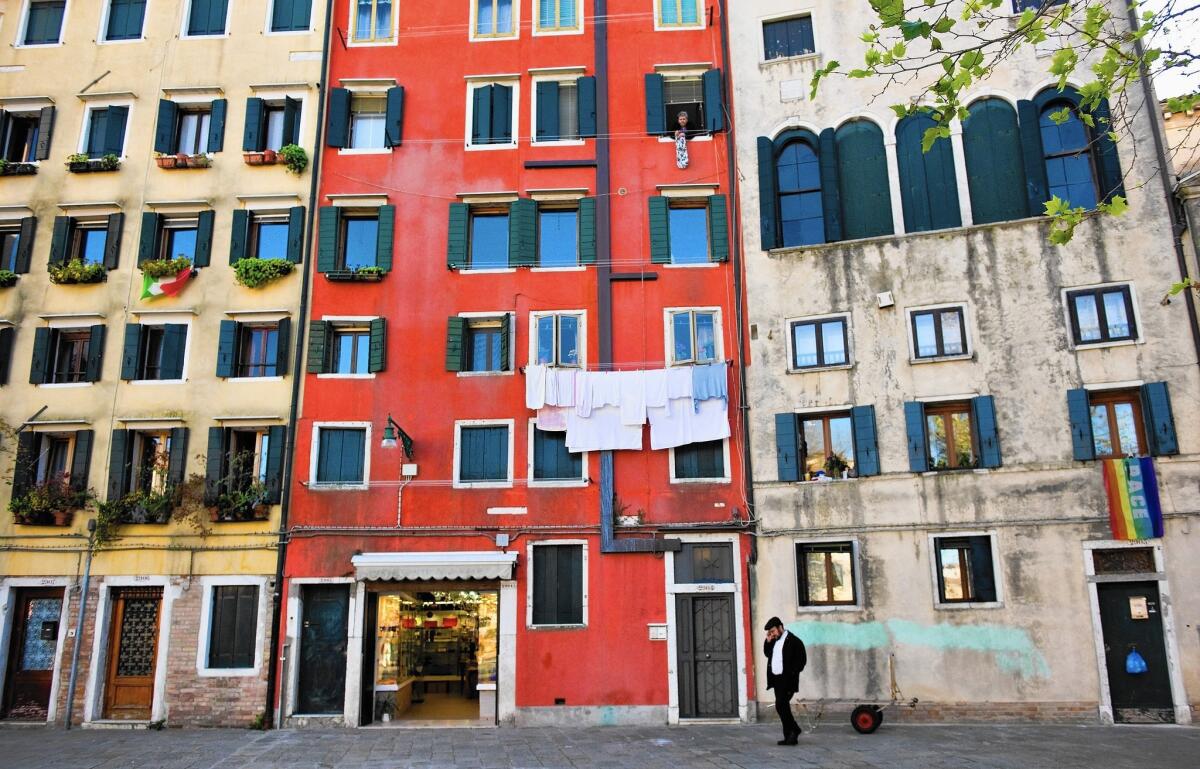Venice Jews work to preserve the world’s first ghetto as 500th anniversary nears

- Share via
reporting from VENICE, Italy — On a cold, blue winter’s day, Shaul Bassi stood shivering in the main square of an ancient Venetian neighborhood as he tried to explain how this was not just a ghetto, it was the ghetto.
“The concept of the ghetto was born here in Venice,” he said. “And that is why we must never forget this place.”
Set up by Venice’s rulers in 1516 on the site of an old metal foundry, and probably the first community in Europe to be segregated by religious belief, the neighborhood took its name from getar, a word in the Venetian dialect meaning “to smelt.”
See more of our top stories on Facebook >>
For the next 300 years, the Jews of Venice, about 5,000 in all, were forced to pay the salaries of the guards who locked them in from midnight to 5 a.m. and patrolled the canal circling the area.
Bassi pointed to the eight-story houses crowded around the square — the tallest buildings in the lagoon city. “They had to build higher and higher and squeeze in low-ceilinged apartments. It was like a beehive,” he said.
This year, as the world’s original ghetto marks its 500th anniversary, Bassi is part of a group of Venetians fighting to raise 8 million euros (about $8.7 million) to restore three precious 16th century synagogues and a museum in the district, which lies yards from streets thronged by the city’s tourist hordes but is rarely visited.
“Millions live in ghettos around the world today, and we are trying to figure out what precious lessons can be drawn from our own experience here,” said Bassi, 46, an English literature professor at the University of Venice.
Joining Bassi in the square, Venice’s chief rabbi, Scialom Bahbout, said that marking the anniversary could prove timely in the battle against anti-Semitism in Europe, which is reportedly on the rise.
“The ghetto was founded on anti-Semitism — a sickness that hasn’t gone away — and remembering it is important because it reminds us that after 500 years of trying to eradicate Jewish culture, not only are we are still here, but Jewish culture made it over the ghetto walls,” he said.
Forced to work as money lenders, clothes sellers or doctors, Venice’s Jews were made to wear yellow caps if they ventured into the city by day, where prejudice was rife. In 1668, a special canal was dug around the outskirts of Venice to allow Jews to reach their cemetery without being subject to insults and stone throwing by Christians.
Bassi carefully went up a rickety staircase and entered one of the three small synagogues tucked away in residential buildings around the square to ensure a low profile.
“The Jews were forced to use Christian architects to build the synagogues; they weren’t allowed to use their own,” he said.
The ghetto, even Bassi acknowledges, is not a beautiful place, but the interiors of the synagogues are hidden gems, bursting with baroque and rococo carvings in wood and gilt. Campaigners like Bassi hope money raised can be used to make them fully accessible to visitors.
The number of synagogues that served different nationalities settling in the ghetto — five — points to an odd truth: Jews flocked to live there.
“Elsewhere in Europe Jews were treated worse, and Venice to some extent was a safe harbor,” said Paolo Gnignati, the head of Venice’s Jewish community. “The city wanted them to come because they needed access to Jewish trading networks; it was good business on the part of the doges,” he added, referring to the Venetian leaders.
In 1541, the ghetto was expanded to offer living quarters to itinerant Spanish and Portuguese Jewish traders. “For the Jews, the ghetto was an acceptable compromise,” Bassi said.
As Jews moved in, cultural and religious activity boomed behind the ghetto gates.
Bassi said that a third of all Hebrew publications in Europe before 1650 were Venetian and that in 1530, when England’s King Henry VIII was searching for Old Testament precedents to justify his divorce of Catherine of Aragon, he consulted with Venice rabbis.
By the next century, Jewish poet Sarra Copia Sulam was hosting a literary salon in the ghetto and being wooed by a Genoese monk who was fixated with her. “Being trapped in the ghetto didn’t block the imagination, it triggered it,” Bassi said.
“Over time,” Gnignati said, “Jewish and Venetian culture intermingled, proving that cultural identities are not immutable.”
Money raised for the anniversary, about $2 million so far, will be used to restore and add space to the ghetto’s small museum for exhibits about the theatrical and artistic life of the area.
Fundraising has been masterminded by the preservation group Venetian Heritage, with support from fashion designer Diane von Furstenberg, and is targeting possible benefactors in the U.S. “An anonymous donor is about to give 3 [million] to 4 million euros,” said Toto Bergamo Rossi, a well-connected Venetian Heritage activist.
Events marking the anniversary, including concerts and exhibitions, will begin March 29, the day Venice established the ghetto in 1516. For the first time, Shakespeare’s “The Merchant of Venice,” with Emmy-winning actor Reg E. Cathey playing Antonio, will be staged in the main square.
For Bassi, the play was a must, even though it gave the world the odious Jewish character Shylock.
“Shylock is the most famous Venetian Jew and we cannot pretend he doesn’t exist,” he said.
The gates to the ghetto were finally knocked down in 1797 by Napoleon when he occupied the city, allowing Jews to live where they chose. A plaque in the square honors the 250 Jews who were taken from Venice to Auschwitz during World War II, never to return. Only about 500 Jews live in Venice today, and just a few in the old ghetto.
One ambition for the expanded museum is that it will host 40 silver crowns, shields and liturgical pieces that were recently found under a synagogue staircase in the ghetto after being hidden there from the Nazis in 1943.
“We were deprived of our rights here, but we preserved our cultural identity, contributed to Europe’s identity and we are still here,” Gnignati said. “We can serve as an example to newcomers who want to participate in Europe while preserving their original identity.”
Kington is a special correspondent.
ALSO
Chinese woman trapped for a month in an elevator starves to death
Egypt denies reports linking police to Italian student’s torture and death
How does China mark Women’s Day? Hold the feminism, bring on the fashion show
More to Read
Sign up for Essential California
The most important California stories and recommendations in your inbox every morning.
You may occasionally receive promotional content from the Los Angeles Times.









